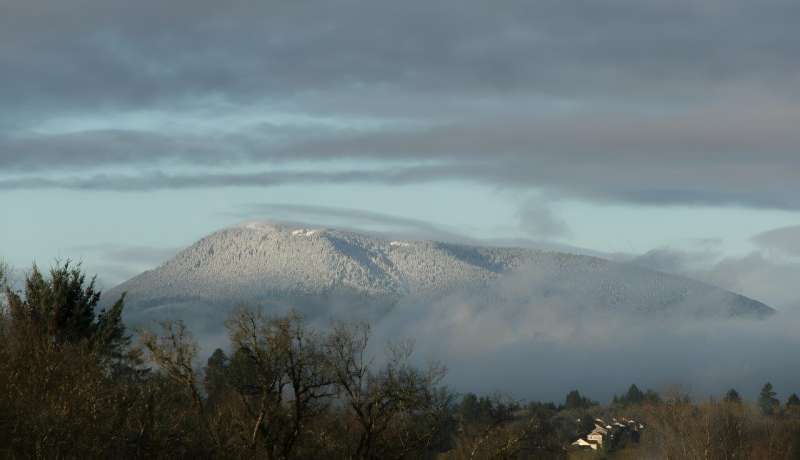This article has been reviewed according to Science X's editorial process and policies. Editors have highlighted the following attributes while ensuring the content's credibility:
fact-checked
trusted source
proofread
Cooler, wetter parts of Pacific Northwest likely to see more fires, new simulations predict

Forests in the coolest, wettest parts of the western Pacific Northwest are likely to see the biggest increases in burn probability, fire size and number of blazes as the climate continues to get warmer and drier, according to new modeling led by an Oregon State University scientist.
Understanding how fire regimes may change under future climate scenarios is critical for developing adaptation strategies, said the study's lead author, Alex Dye. Findings are published in the Journal of Geophysical Research: Biogeosciences.
Dye, a faculty research associate in the OSU College of Forestry, and collaborators with the U.S. Forest Service conducted novel, comprehensive wildfire simulations for more than 23 million acres of forest land west of the Cascade Range crest in Oregon and Washington.
The simulations showed that by the 30-year period beginning in 2035, Washington's North Cascades region, the Olympic Mountains, the Puget Lowlands and the western Oregon Cascades could see at least twice as much fire activity as was observed during the prior 30 years, Dye said.
To a lesser degree, that trend holds for the western Washington Cascades and the Oregon Coast Range, he added.
Forests in all of the affected areas are linchpins of multiple socio-ecological systems in the Northwest, Dye said, meaning more fire will likely put pressure on everything from drinking water sources and timber resources to biodiversity and carbon stocks.
"The moist, highly productive forests of the Northwest don't get fire as often as other parts of the West, like California or eastern Oregon," Dye said. "But fire does naturally occur in the PNW 'Westside,' as we call it—the fire regimes are actually quite complex in this region. It can be challenging to assess fire probability in an environment where there isn't a lot of empirical information about the fire history to build models."
The comparative infrequency of fire also means it's easy for the general public to think of the Westside as not a high-risk area, and it also means the region is generally not a focal point of studies such as the one he just completed, Dye said.
But recent big blazes such as those that occurred in the Northwest around Labor Day 2020 showed what can happen when severe fire strikes Westside areas.
"And what if fires like that were to start happening more frequently in the near future?" Dye said. "What if that once every 200 years became once every 50 years, or once every 25 years as climate change brings hotter and drier conditions to the region?"
Climate is just one factor influencing wildfire, he noted, but it is an important one. He sees the findings as a crucial planning tool to help the Northwest prepare for a rapid acceleration of fire over the next few decades.
"Describing the possibilities of how, when and where climate change could affect fire regimes helps bracket everyone's expectations," he said. "Particularly important among our findings are new insights into the possibility of shifts towards more frequent and large fires, especially those greater than 40,000 hectares as well as shifts toward more fires burning at the beginning of fall when extreme weather has the potential to increase fire spread."
Forty thousand hectares is just under 99,000 acres.
Collaborating with Dye on this study were Andy McEvoy and Rebecca Lemons of the OSU College of Forestry and Matt Reilly, Karin Riley, John Kim and Becky Kerns of the Forest Service. Reilly and Kim work at the Western Wildland Environmental Threat Assessment Center in Corvallis, Kerns is at the Pacific Northwest Research Station in Corvallis, and Riley is based at the Rocky Mountain Research Center in Missoula, Montana.
More information: Alex W. Dye et al, Simulated Future Shifts in Wildfire Regimes in Moist Forests of Pacific Northwest, USA, Journal of Geophysical Research: Biogeosciences (2024). DOI: 10.1029/2023JG007722
Provided by Oregon State University





















